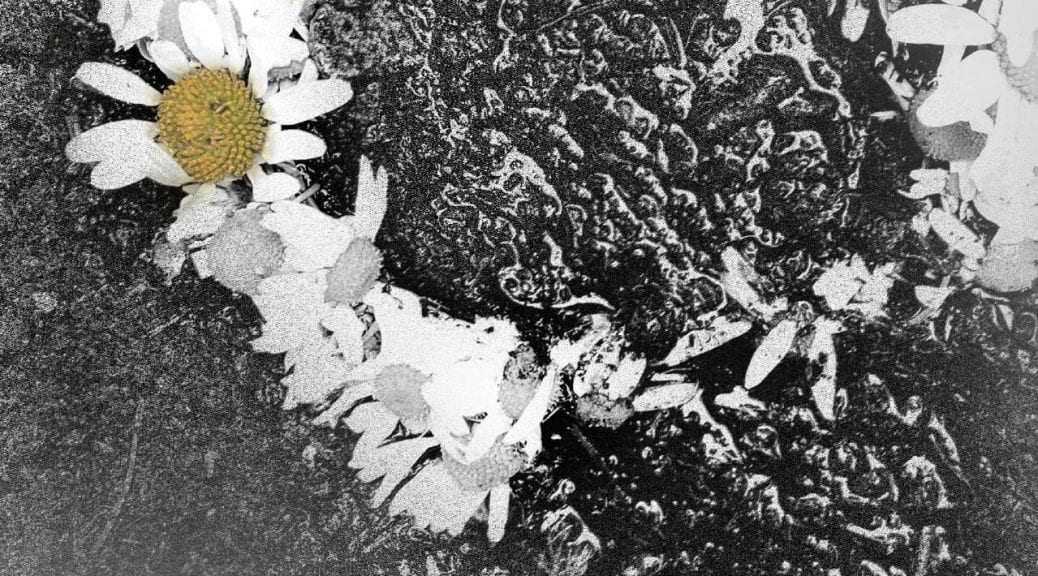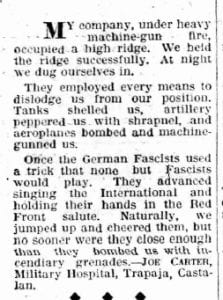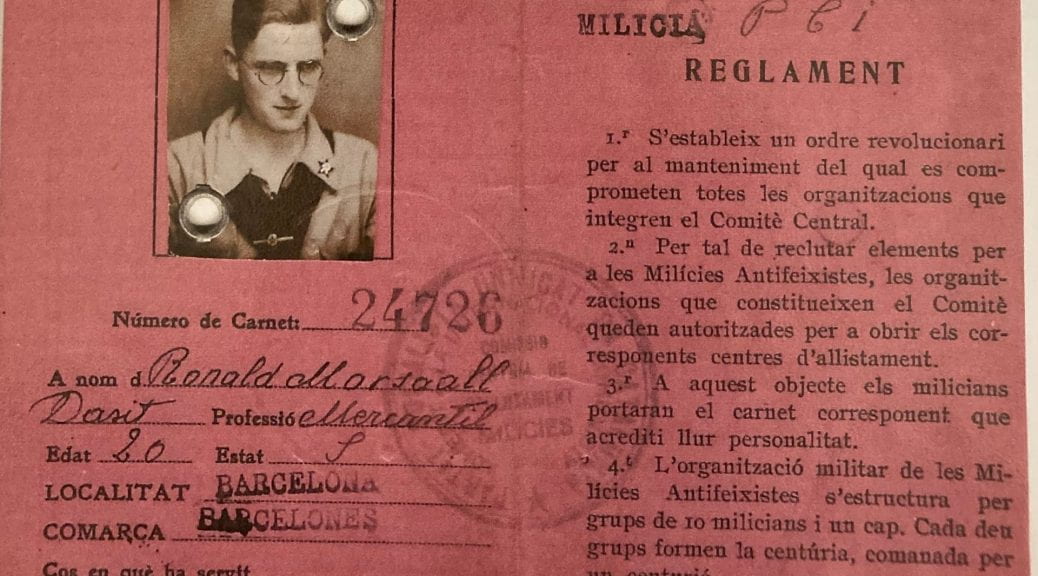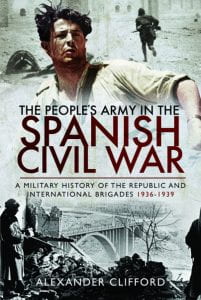Soldiers in the Fog by Antonio Soler
Original title: El nombre que ahora digo.
Translated by Kathryn Phillips-Miles & Simon Deefholts
ISBN 978-1-013693-31-2
Release date: 14 September 2023
https://theclaptonpress.com/soldiers-in-the-fog/

On Monday 8th February 1937, Franco’s Nationalist troops; aided by German and Italian troops, tanks, warships and planes, invaded Malaga. The civilians who fled from this onslaught had just one road to get away and this had, on one side high peaks and on the other the sea. Italian plane and Fascist artillery bombarded the road and in addition there was no food or transport for the refugees as they fled towards Almeria.
I have a special interest in this well documented atrocity as it was recorded in detail and publicised at the time primarily by the Mobile Blood unit headed by the Canadian surgeon Norman Bethune. Bethune’s unit transported the blood of donors to the Republican front, he was assisted by Hazen Sisen and Cuthbert Worsley.
In February 1937 the Mobile Blood unit was driving from Almería to Málaga to help after the fall of this city when they encountered the beginning of the refugee flow. Over the next few days and nights they worked tirelessly to save many lives, help the refugees to get to Almeria and record the event. On the evening of 12th February 1937, Almería, packed with 40,000 exhausted refugees, was heavily bombed by Italian and German aircraft. Bethune records the Malaga road and Almeria attacks in The Crime on the Road Malaga – Almeria, published in 1937. Cuthbert Worsley would also publish an account in 1939 in his Behind the Battle.


The major reason why this war crime is of particular interest to me is because Cuthbert Worsley is one of the fifteen volunteers from Durham; and the surrounding pit villages, that I am researching and writing about for the rededication of the Durham International Brigade memorial in Redhills; The Miners Hall in Durham.

Soldiers in the Fog is not an historical account, it is historical fiction; Antonio Soler draws upon the experiences of Republicans during the Civil war, he uses these experiences to enhance and influence his fictional narrative. Soldiers in the Fog begins with the champion of the book, a young soldier named Gustavo Sintora, arriving in Madrid, having escaped from Málaga. Therefore, the accounts from Bethune and Worsley were firmly in my mind as I started reading. However there are no graphic descriptions of the horrors witnessed on the Malaga – Almeria road, they are vaguely alluded to by Sintora so briefly that anyone without knowledge of the event would miss the reference. Thus Soler gives us a very human story, with the focus firmly on the individuals.
The narrative journey begins with Gustavo Sintora being posted to a Republican mobile army entertainment unit, stationed in the outskirts of Madrid. The entertainers are an eclectic and exotic mix, extraordinary and unusual. It seems that these characters would ordinarily be outsiders, they seem not to fit into ordinary Spanish society, but in these exceptional times ordinary society no longer exists. At first I made the superficial correlation with the television programmes MASH and It ain’t half hot mum, but there was nothing funny about the characters or the situations they found themselves in, but there is some similarity. At first the members of the mobile army entertainment unit are so diverse and unusual they are more like stereotypes than real people; grotesque aberrations who seem surreal, an impression which is enhanced by Solar’s descriptions and the initial interactions between them and Sintora.
The grotesque continues in the narrative, this isn’t a comfortable read, it is challenging, and I admit I was disturbed by a few aspects, this is far from an historical account of the Spanish War, and far from being an accurate account of the Republican experience. The Republic and the Republican soldiers are not represented favourably, in fact in a few cases the author appears hostile.
Very early, in one of the opening chapters, a scene felt so out of place that it upset the rhythm of the novel, I felt the author had made some odd choices. It started off with Sintora finding himself in a camp for Russian Airmen, there were just under 200 soviet pilots in Spain at this time therefore this seemed implausibly lucky. Solar adds to the incongruity by using the well-worn cliché of representing these Russians as constantly drunk and aggressive. Credulity is stretched further when Sintoria witnesses the brutal and sadistic execution of two of the Russian airman by their own officer, allegedly for treason. The scene ends with the other Russian airman casually strolling off, leaving the bodies of their comrades out in the open. Most Historians agree that the Soviets sent between 2,000 and 2,500 Soviet military personal to Spain, mostly as specialists and instructors. Therefore it is highly unlikely that the lives of these valuable specialists would be seen as expendable by their officers. Even if we accept that it may have happened it would not have occurred in such an open way, the NKVD or SIMS would not operate like this and the Soviets would be well aware of the propaganda implications; a trial and execution usually occured out of sight, if not back in the Soviet Union.
 Soviet pilots on the Soto airfield near Madrid.
Soviet pilots on the Soto airfield near Madrid.
In a later section Stalin is lampooned by Republican soldiers, I am not saying this is unlikely, in fact the opposite, it is highly likely. However this is the only instance in which soldiers mock a leader, it appears odd that of all the leaders involved in the Spanish War the author chooses a supporter of the Republic; Stalin’s Soviet Union was one of the few and the most significant providers of material aid to the Republic. Franco nor any of his Generals are never mentioned let alone criticised or lampooned.
These minor oddities did not distract from the beauty of the narrative, however. The narrative is wonderfully interwoven throughout with excerpts from Sintora’s imaginary notebooks, a clever literary device which is used successfully. According to the story, Sintoria had handed over these notebooks to the narrator’s father, and now the narrator was exploring them. These fictitious notebooks are used to stich the story together, with the narrator elaborating on the entries, this allows him to bring in thoughts and feelings which rapidly become the driving force propelling the narrative forward. The result of this literary devise is that the reader empathises with the characters, we see their hopes and dreams, which are familiar.
As the story slowly develops the unusual assembly of characters are transformed, after some time we see them expressing hopes and desires which are recognizable, the characters cease to be unusual but still retain the extraordinary. I gradually came to realise that these extraordinary characters have become exceptional because of the situations they have found themselves; namely they are caught up within a Civil War.
Sintora is a youth so the chief desire we see is love, the desire to be loved; on joining the unit Sintora meets Serena Vergara, the unit’s seamstress who becomes his focal point and sole thought, unfortunately Serena is married to the violent Corrons and as a result Sintora is warned off her, not only by Serena herself but by the other soldiers in the unit. Despite this and the fact that Serena is old enough to be his mother, he is undeterred – the notebooks make clear that she becomes the love of his life. This growing relationship binds the narrative, it also highlights Sintora’s strengths and weaknesses; he is young, with little experience in relationships, but he is determined and loyal.
Because Serena is much older than Sintora we see, and even feel, his insecurities; he is drawn to her but because of self-doubt and Spanish tradition he is reticent and uncomfortable approaching her; he also fears the ridicule of the other men. In this way Solar humanises the character of Sintora wonderfully, he does this with the rest of the unit members also. We come to see their behaviour and emotions as perfectly logical, which allows us the empathise deeply.
I initially found the language unusual too, the sentence structure seemed odd, and then I realised that the translators have not rewritten the text in English, they appear to have produced a translation that remains true to the original text, which is wonderful as at times the text can be quite beautiful. The start is a case in point:
A dead person is a memory but back then, during the war, they were part of a landscape, a sunset that appeared at a bend in the road even if it was still mid-morning, a flower, a neglected bush that nobody bothered to water, that grew anywhere, casting shadows over the street corners and the streets themselves.
I found myself savouring the text, which meant a careful reading of the book. This had two benefits; firstly I lingered over the text which gave me an appreciation of the words used and the construction of the paragraphs, I was reading to cherish the writers art, something I do with poetry and a very exclusive number of books. The second benefit was that it helped me became deeply absorbed in the story and the characters: I was not reading the text to find out what would happen next, but rather to give me aspects to think about. The narrative led me to think about relationships, comradeship, fears and hopes.
Gradually I realised that what was missing in the initial chapters of the book was the war, the characters were occupied with mundane tasks; transporting the artists, maintaining the vehicles or sorting out the small disputes that arise when strangers live and work in close proximity. The war was ever-present but it was in the background.
When the war does audaciously impose itself upon the life of the characters it comes as a profound shock, it is short, violent and quickly over, but leaves a lasting frustration and confusion. For me this aspect highlighted the skill of the writer; Solar is not writing about the Spanish Civil War, he is demonstrating the effects of this conflict on human beings and more widely the effects of war on society. This is where I found the title so appealing, the analogy of a fog can be used to fit a number of circumstances. A fog can mask so much from view, it also disorientates. The characters find that the Civil War does both, it hides aspects of the war and individuals can hide aspects of themselves, but it will also reveal aspects which have been hidden. The interaction between the characters also creates a fog, a veling of thoughts and motives which leads to suspicion and conflict.
In terms of action, for most of this novel there is very little, the brief outbreaks of violence highjack the reader, without preamble they erupt swiftly and brutally, leaving the characters, and the reader a little shocked. The situations the characters inhabit are mundane and ordinary, with a major part of the book taken up with dialogue between the characters. The sheer ordinariness of the situations are a counterpoint to the thoughts and expressions of the characters, this leads to a surreal, almost dreamlike progression of the story. The characters go from a mundane situation to a bizarre situation so gradually that the reader does not realise that the situation has become outlandish.

This aspect reminded greatly of my absolute favourite book; The Master and Margarita by Mikhail Bulgakov, a satire where the devil and his bizarre entourage visit Moscow under Stalin. Here they create surreal situations, but as the Soviet Union under Stalin is so bizarre and surreal, they seemingly fit right in. There are aspects of Soldiers in the Fog where one feels this is also the case here, the characters actions are so out of place that, in isolation they appear bizarre, but when taken in the context of the Civil War these actions are perfectly understandable. Soler perfectly reflects an experience of war that is so ridiculous it almost defies description, the dark situations are almost comic, there is certainly an element of black humour in the dialogue and situations, but as the war overshadows everything these are far from being funny. In The Master and Margarita Bulgakov has the devil narrating the thoughts of Pontius Pilate, the ‘Procurator of Judaea’ in sections that are then interspersed between the main ‘Moscow’ chapters. In Soldiers in the Fog Solar inserts Sintora’s notebooks into the narrative in a similar random fashion. The Notebooks, the thoughts of Sintora are rarely used to introduce the scene, they sometimes seem unrelated to the section of the narrative, which adds to the complexity and disorientation of the situations.

There is a similarity too to Joseph Heller’s Catch-22, the characters appear to be exercising free will, especially as they are not subject to the military discipline seen in regular units, but ultimately they are victims of the situation. As well as the paradox’s the characters come across a further comparison with Catch-22 is the characterisation, as with Heller, Solar’s ‘hero’ of the book is not the most prominent character; Sintora it clearly the junior in the unit, the new face who needs to fit in with the established members. This means that the majority of the named characters are described in detail, Solar writes them all as multidimensional personas, which means that there are only a small number of incidental characters, allowing the reader to empathise with all the members of the unit. I think this reflects Solar’s underlying message that this Spanish Civil War has no heroes, only victims.
The war affects the characters in multiple subtle ways, seemingly creating confusion and disruption. The characters seem to be in a constant state of great confusion, unable to plan or navigate the way ahead. This state of perplexity makes the title Soldiers in the Fog so fitting, when I mentioned this to Simon; one of the translators, he replied:
we agonised for months over the title and then had to come clean with the author that it didn’t really work in English and came up with Soldiers in the Fog. He was very happy because his working title for the novel (in Spanish) was A Soldier in the Fog, which his Spanish Publishers had insisted on changing. [To The name that I now say ]
The book has such a steady pace that on the rare occasion that violence breaks into the rather tranquil world of the support staff the event it is truly shocking, overturning the sense of stability that the pace establishes. I am hugely impressed by how skilfully this is written, we only get the odd glimpse of the events of the Civil War, experiencing hints and insinuations on what is happening in places none too distant, the War is in the background, overshadowing the actions of the characters, but not overtly oppressive.
The oppression is implied but constant, throughout the novel we have the feeling that the war will have to eventually catch up with the characters in a big way, that the dam will burst and it will become much more than an inconvenience; as the pressure builds we see how this pressure influences the way the characters behave. The characters become more frantic and unpredictable. The tension created by the war and the unusual life the characters are living gradually erodes their stable, if rather erratic, living arrangements; leading to more and more bizarre behaviour. At first we see bizarre characters behave normally and normal characters behave outlandishly, but the singular situations created by a nation at war exerts an influence in which normal behaviour becomes irregular and sometime abhorrent, we see the characters desperately trying to create a mental state necessary for surviving in a time of war.
As the war becomes darker and more intense, the pretence at stability the characters try to create is disturbed more and more frequently, the war invades the world of the mobile army entertainment unit more and more frequently and more and more deeply.
 On 25 July 1938 the Republican army began to cross the River Ebro
On 25 July 1938 the Republican army began to cross the River Ebro
Eventually Sintora’s unit is sent into action on the Ebro front, the crucible of the Civil War. Despite denying the possibility it is when finally faced with the horrors of the battlefield and the inevitability of Republican defeat that the unit disintegrates. The orgy of violence stands in stark contrast with what had been described before. The characters destroy the relationships carefully built up over the course of the novel. I found this aspect shocking, I had come to empathise and sympathise with most of the characters, but in the ending a lot of this empathy is betrayed; a number of characters behave abhorrently. I was shocked and came to question my sympathy for them, but the wonderful narrative means one has to have sympathy for these characters as they struggle to avoid drowning in despair as the certainty of defeat pervades their world.
When the collapse comes it comes as a great shock, everything Solar has built up is tainted by the disintegration of the new norms, the collaboration, the civility and humanity disappears, consumed by the chaos of war. I think this is a fantastic reflection of the effects of the Battle of the Ebro on the latter stages of the War. The last death is horrifying in its brutality: an enemy plane drops a bomb, hitting a car and literally blowing the car and its occupants to pieces; bringing a disturbing correlation with the attack on Guernica.
I am impressed that Soler does not spares us the details of the shelling, bombing, artillery and the bitter cold, he hints at it for most of the novel, and occasionally gives us small examples but then at the end as the characters are thrown into the fighting, he hits the reader with the true hideousness of 20th Century Warfare, plunging us head first into the horror and squalor of war on a purely human level.
Thankfully most of characters survive, but after this experience it does not feel like a relief. I empathised with the obvious effects of trauma the characters display, and felt the tragedy of the experience, not only for the individuals but for Spain. The ending of the book did not feel like an end, it truly felt like a defeat.
One line at the end really struck me: Captain Villegas tells Sintora.
I don’t really know, but I think they’ve killed me too. I think I’m a dead man, dead like the men who were with me.
It highlighted for me one of the many tragedies of the Spanish Civil War, the fact that the Republicans were unable to mourn their dead, it was a glorious cause for which they fought but those that were killed, both soldier and civilian, died in vain; Fascism was triumphant. The ending left a void which I think is present in our remembrance of the Spanish Civil War, the sacrifices and efforts all came to nought.
I think Soldiers in the Fog transcends historical fiction, it is set during the Spanish Civil War, the author has used this to highlight many aspects unique to this tragic conflict, but this is not about the men and women who were caught up in this conflict. I believe that this impressive book explores the challenges people face in order to retain their humanity in a time of total war – warfare in the 20th Century. This is a truly remarkable book, the translation is a masterpiece of the art of converting a given text into a another language without losing the spirit. I will cherish this book and reread it often.

 At the time all I could recall was that Alexander Guchkov had put the pen in the Tsar’s hand and told him to abdicate, which may be because the image above has been used in numerous textbooks. It is Alexander Guchkov who is standing behind the Tsar. In the Provisional Government Guchkov was Minister for War. Although I was excited by this I had promised Masha that I would look into her father’s time in Spain.
At the time all I could recall was that Alexander Guchkov had put the pen in the Tsar’s hand and told him to abdicate, which may be because the image above has been used in numerous textbooks. It is Alexander Guchkov who is standing behind the Tsar. In the Provisional Government Guchkov was Minister for War. Although I was excited by this I had promised Masha that I would look into her father’s time in Spain. 7 Alma Place, North Shields
7 Alma Place, North Shields
 Robert Jr went to Oundle School and then Kings College, Cambridge, where he took History, played cricket and rowed. Robert was at Cambridge at the same time as The Cambridge five who were all at Trinity College, Robert was at Kings College, just a courtyard away.
Robert Jr went to Oundle School and then Kings College, Cambridge, where he took History, played cricket and rowed. Robert was at Cambridge at the same time as The Cambridge five who were all at Trinity College, Robert was at Kings College, just a courtyard away. I could write books on Vera Traill, but as I’m writing about Masha’s father, Robert, I’ll just give you the description that accompanies her MI5 files as a taster:
I could write books on Vera Traill, but as I’m writing about Masha’s father, Robert, I’ll just give you the description that accompanies her MI5 files as a taster:






































